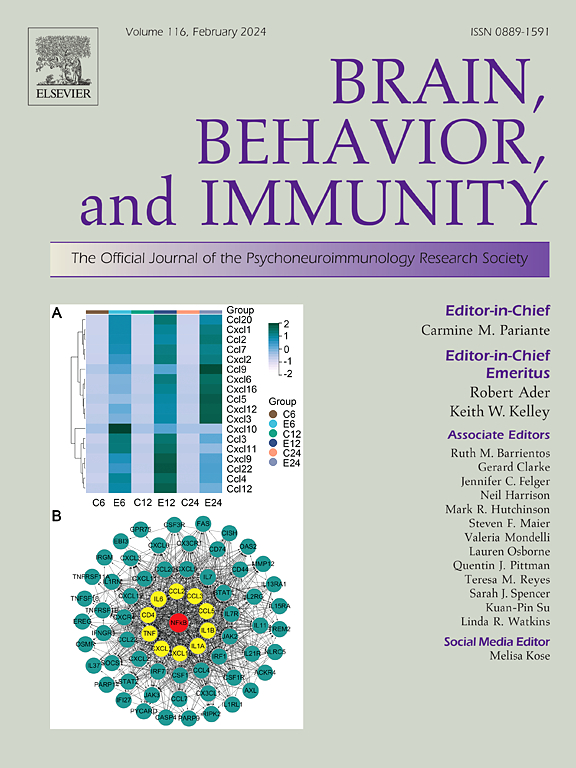在氧化应激位点靶向激活Nrf2可逆转阿霉素诱导的小鼠认知损伤
IF 7.6
2区 医学
Q1 IMMUNOLOGY
引用次数: 0
摘要
虽然由于治疗方法的进步,癌症存活率有所增加,但化疗通常会带来长期的神经毒性副作用,从而降低生活质量。通常受影响的领域包括记忆、执行功能、注意力和处理速度,被称为化疗引起的认知障碍或“化学脑”。大脑中的氧化应激和神经免疫信号与化疗对认知的有害影响有机制联系。考虑到这一点,我们测试了使用化合物1c或富马酸地洛西梅尔(DRF)激活抗氧化反应核因子e2相关因子2 (Nrf2)是否会恢复阿霉素治疗后的认知功能。化合物1c是一种前药,它在氧化应激位点特异性地局部释放Nrf2激活剂富马酸单甲基(MMF),而DRF则全身释放MMF。在雄性和雌性小鼠中,化合物1c和DRF都逆转了阿霉素引起的执行功能、空间和工作记忆缺陷。Nrf2激活剂降低阿霉素诱导的海马丙二醛和蛋白羰基水平。与此一致的是,1c在阿霉素治疗后增加了海马中Nrf2的核易位(激活),而DRF也不加选择地激活了小鼠海马中的Nrf2。在Nrf2敲除小鼠中,化合物1c和DRF的治疗作用消失,证实了Nrf2是治疗靶点。Nrf2激活剂逆转了阿霉素诱导的突触蛋白PSD95的缺失,恢复了海马的小胶质细胞形态,而药物治疗对成人神经发生没有显著影响。这些结果证明了Nrf2激活剂在逆转阿霉素诱导的认知障碍以及海马中相关的结构、表型和分子变化方面的治疗潜力。血红蛋白在氧化应激部位局部释放MMF有可能减少富马酸盐的不良影响,同时逆转阿霉素诱导的CICI。本文章由计算机程序翻译,如有差异,请以英文原文为准。
Targeted activation of Nrf2 at sites of oxidative stress reverses doxorubicin-induced cognitive impairments in mice
While cancer survivorship has increased due to advances in treatments, chemotherapy often carries long-lived neurotoxic side effects which reduce quality of life. Commonly affected domains include memory, executive function, attention, and processing speed, known as chemotherapy-induced cognitive impairment or “chemobrain”. Oxidative stress and neuroimmune signaling in the brain have been mechanistically linked to the deleterious effects of chemotherapy on cognition. With this in mind, we tested if activation of the master regulator of antioxidant response nuclear factor E2-related factor 2 (Nrf2) using compound 1c or diroximel fumarate (DRF) would restore cognitive function after doxorubicin treatment. Compound 1c is a prodrug which locally releases the Nrf2 activator monomethyl fumarate (MMF) specifically at sites of oxidative stress, while DRF systemically releases MMF. Compound 1c and DRF both reversed doxorubicin-induced deficits in executive function, and spatial and working memory, across male and female mice. Nrf2 activators decreased malonaldehyde and protein carbonyl levels induced by doxorubicin in the hippocampus. Consistently, 1c increased nuclear translocation (activation) of Nrf2 in the hippocampus after doxorubicin treatment, whereas DRF indiscriminately activated Nrf2 in the hippocampus of vehicle-treated mice as well. Therapeutic actions of compound 1c and DRF were lost in Nrf2 knockout mice, confirming Nrf2 as the therapeutic target. Nrf2 activators reversed doxorubicin-induced loss of synaptic protein PSD95 and restored microglial morphology in the hippocampus while there was no significant effect of the drug treatment on adult neurogenesis. These results demonstrate the therapeutic potential of Nrf2 activators to reverse doxorubicin-induced cognitive impairments, and associated structural, phenotypic, and molecular changes in the hippocampus. The localized release of MMF by 1c at sites of oxidative stress has the potential to diminish unwanted effects of fumarates while reversing CICI induced by doxorubicin.
求助全文
通过发布文献求助,成功后即可免费获取论文全文。
去求助
来源期刊
CiteScore
29.60
自引率
2.00%
发文量
290
审稿时长
28 days
期刊介绍:
Established in 1987, Brain, Behavior, and Immunity proudly serves as the official journal of the Psychoneuroimmunology Research Society (PNIRS). This pioneering journal is dedicated to publishing peer-reviewed basic, experimental, and clinical studies that explore the intricate interactions among behavioral, neural, endocrine, and immune systems in both humans and animals.
As an international and interdisciplinary platform, Brain, Behavior, and Immunity focuses on original research spanning neuroscience, immunology, integrative physiology, behavioral biology, psychiatry, psychology, and clinical medicine. The journal is inclusive of research conducted at various levels, including molecular, cellular, social, and whole organism perspectives. With a commitment to efficiency, the journal facilitates online submission and review, ensuring timely publication of experimental results. Manuscripts typically undergo peer review and are returned to authors within 30 days of submission. It's worth noting that Brain, Behavior, and Immunity, published eight times a year, does not impose submission fees or page charges, fostering an open and accessible platform for scientific discourse.

 求助内容:
求助内容: 应助结果提醒方式:
应助结果提醒方式:


